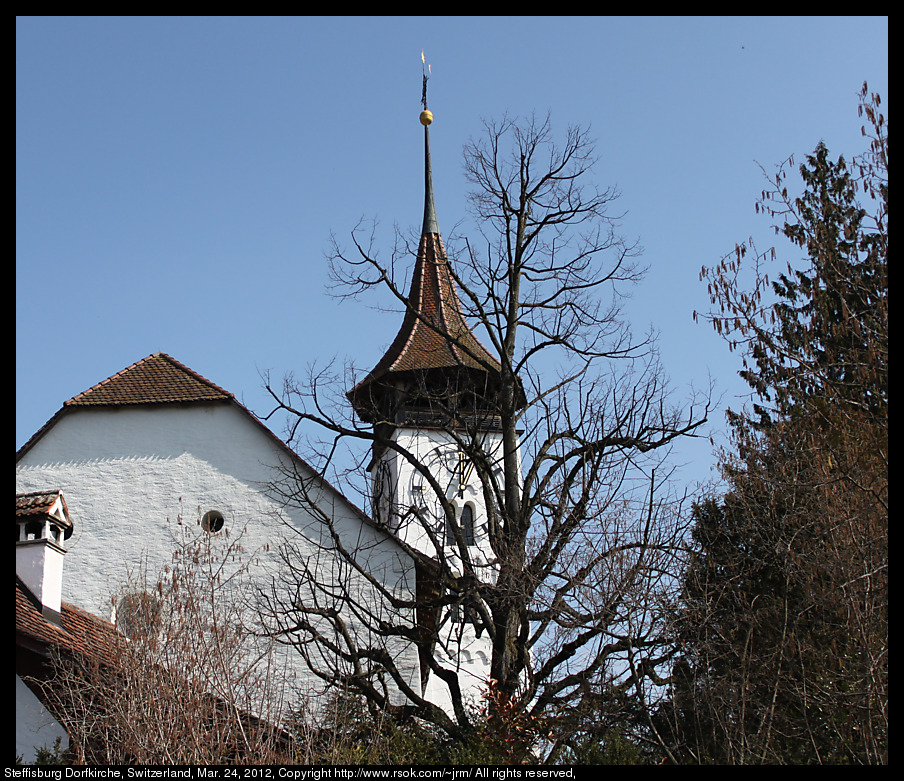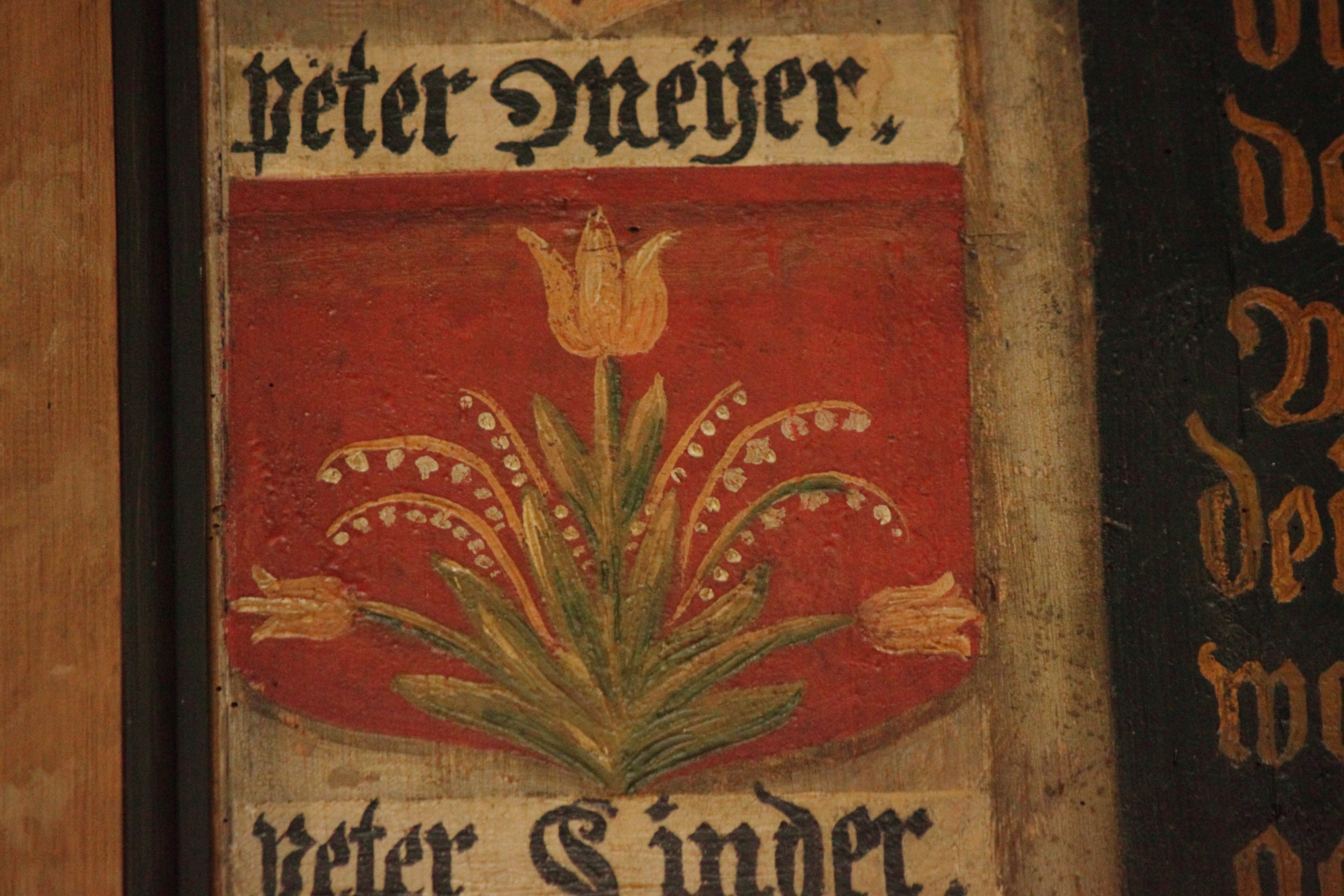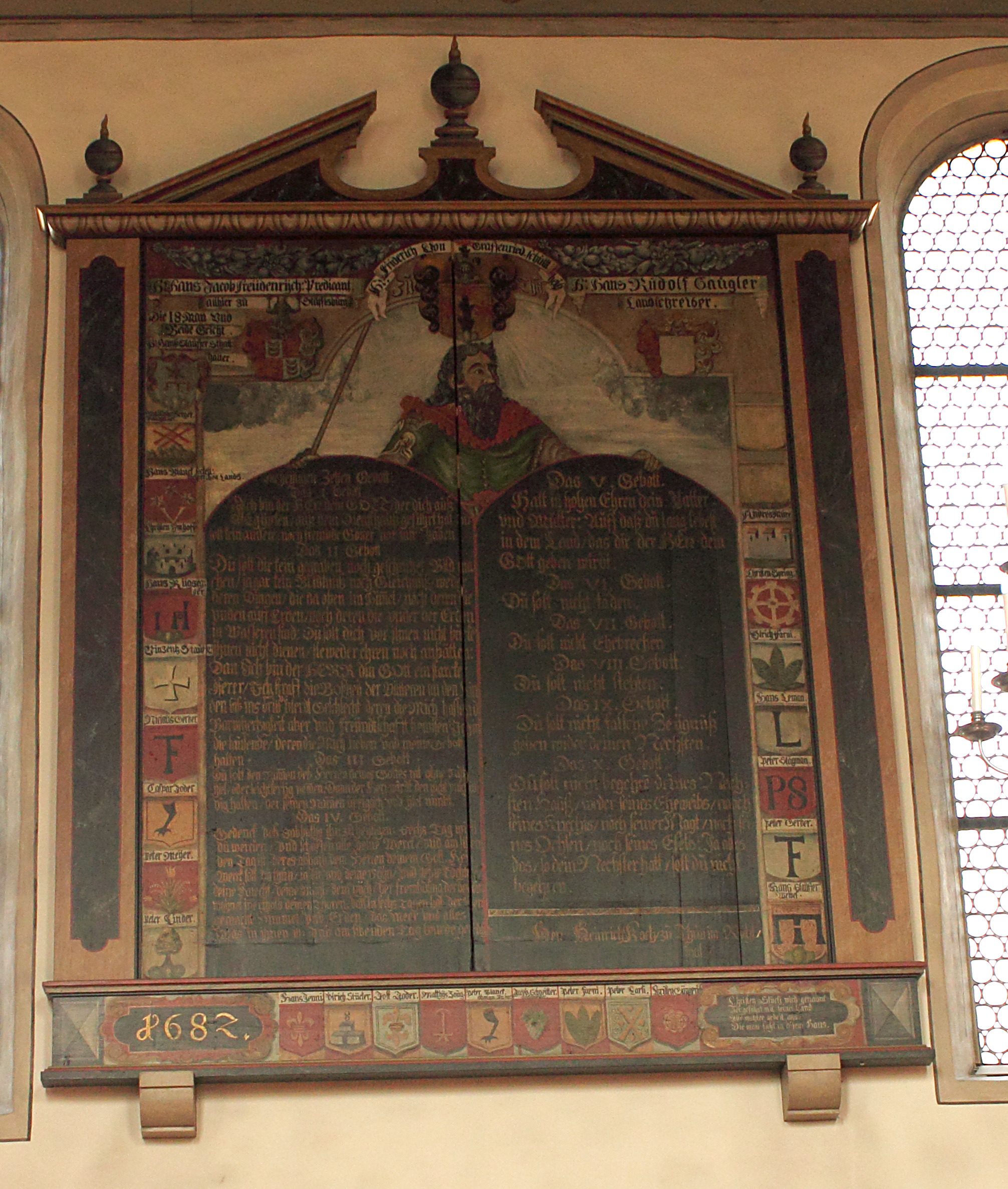I speculate that my Meyer ancestors may have come from near Steffisburg, Switzerland to Pennsylvania.
Rev. Peter Meyer, together with his three brothers, William, Jacob, Henry, one sister (name not known) and their mother (a widow) came to America about 1741 or later. The family were born and lived in Switzerland, but fled from the fatherland during the fierce persecution of the Mennonites by the Calvinists, or State (Reformed) church, to the Palatinate in Germany, were [SIC] they remained with friends in the vicinity of Kerbach for about a year, after which they emigrated to America. The mother married a second husband by the name of Nickey Schaafroth, but had no issue by this marriage. The sister was the oldest of the children. She married a man by the name of Schatz, but had no issue. Of the brothers, Peter was the oldest and Henry the youngest. Peter, William and Henry settled in Springfield township, Bucks county, and Jacob at Centre Valley, Saucon township, Lehigh county. They were all farmers and members of the Mennonite church. It is said that Peter was a minister in Switzerland. He was one of the early ministers of the Mennonite chruch in Springfield. Jacob was also a minister, and preached in the Saucon Mennonite church.
Kerbach is now in Mossel, Lorraine, France. It is difficult to find records of the move of the Meyer family from Switzerland to Pennsylvania. They were outlaws in Switzerland because they were Anabaptists and did not get their children baptized in the reformed church. Some Amish moved from Steffisburg to near Kerbach and then to Pennsylvania. The Amish included Yoders who married Meyers, both in Steffisburg and in Pennsylvania. I have read that if some one left the Amish church, then they were removed from the church book. The Meyer family became more liberal Mennonites in Pennsylvania.
A Henry Moyer is listed in the 1790 US Census. "3 free white males 16+", 1 "free white males 0-16", 4 "free white females" This seems to be the correct number of people if all were living at home.
1741 Molly (Snow)
[List 88 A, B, C] Molly (Snow)
Captain: John Cranch
From: Rotterdam
By Way of: Plymouth
Arrival: Philadelphia, 26 Oct 1741
A list of the Palatine men from 16 years of age and upwards: 47 men. Total freights: 70.6.
Peter Meyer, 20
Here is a photo of the Steffisburg Dorfkirche.

Translated to English by Google
http://www.refsteffisburg.ch/index.php?page=314The Steffisburg village church stands on a Nagelfluhrippe above the upper village, and in 1224 was first mentioned in a document. In pre-Reformation period they belonged to the bishopric of Constance. The archaeological excavations of the years 1980/82 showed, however, that here in the 7th or 8 Century the first Christian church was built. The found structures of a secular building probably are even older.
Already in the 10th or 11 Century was the third church plant here in the architecture of a three-aisled Romanesque basilica early, whose roof was destroyed by fire in 1300.
The present church was built by Abraham Dünz I. 1681 in the form of a longitudinal Protestant sermon hall. The present-day southern and western walls are mostly of the original walls of the Romanesque s Basilica. The 1000-year-old masonry with the still intact "Pietra rasa-plaster joints" of the south facade is a treasure. The brick tower was built in 1320 in Romanesque design. Today's wooden porch and bell tower of the helmet are from 1740.
The church was extensively restored in 1980 and 1983 and equipped with a mobile seating, so that can be performed in addition to the Sunday worship word, unconventional events during the week. Thanks to the excellent acoustics many concerts are held, as a church wedding it is very popular.
In the church there is a plaque with the 10 commandments and the names of those who contributed to the rebuilding of the church in 1682. These photos are large and may require some scrolling to view and a long time to load from my slow server.


I was pursuing the theory that the ancestors of the Amish at Kerbach and Forback in about 1740 who came from Steffisburg might be also my ancestors. "All large communities had a Chorgericht, an ecclesiastical court that enforced religious doctrine in the community. It was an open secret that the one in Steffisburg was unusually tolerant. An enameled tableau called the Mosestafel, installed in the Steffisburg church as it was being rebuilt in 1682, displays the names and coat of arms boards (Wappentafel) of local families along its borders. Almost all of the individuals represented had relatives who chose Anabaptism: 1 BOTTOM (left to right): Hans Jenni; Ulrich Stücker; Jost Joder;2 Matthÿs Zoüg; Petter Blanck, Obmann; Jacob Schneitter, Seckelmeister; Peter Farni, Peter Carli [or Earli], and Christen Güngerich.3 LEFT (bottom to top): Peter Linder; Peter Meÿer; Caspar Joder; Niclaus Gerber; Vinzentz Stauffer; Hans Rügsegger; Christen Imhoff;4 Hans Blanck, Seckelmeister des Lands; and Mathÿs Berger, Statthalter. RIGHT (bottom to top): Hans Stauffer, Weibel; Petter Gerber; Peter Stägmann; Hans Lehmann; Ulrich Farni; Christen Spring; Andres Maire; and two empty spaces. It is likely that this was the Ulrich Stücker who was born in 1654 and married Christina Reusser. His family coat of arms appears as a simple letter 'S' over three white boxes. The boxes are arranged with one behind the other two. It has been suggested that they represent building blocks, indicating that Ulrich was a stonemason, but it is more likely that they represent three barns. On Oct. 8, 1693, a reformed church was established at Schwarzenegg (between Steffisburg and Eriz) under Pastor Johannes Herzog. The Evangelisch-Reformierte Kirche, Schwarzenegg bei Thun served a parish that included Eriz, Horrenbach, Oberlangenegg, and Unterlangenegg. There may have been more than one reason for the establishment of a new church. Two years earlier, the pastor at Steffisburg had begun to keep notations in his records indicating which children had Anabaptist parents. Pastor Herzog of Schwarzenegg was more discrete."
Amische und Täufer zu Besuch in SteffisburgAm 10. Juli 2003 besuchte eine Reisegruppe von Amischen und Täufern die Dorfkirche Steffisburg. Ihr Interesse galt ganz speziell der Mosestafel in der Kirche. Nicht die 10 Gebote, sondern die Namen und Wappen interessierten die Gäste ganz speziell. Die Mosestafel ist datiert aus dem Jahr 1682, also ein Jahr nach dem Umbau der Dorfkirche in eine einschiffige Basilika. Auf der Mosestafel sind mit Namen und Wappen die Familien erwähnt mit dem damaligen Pfarrer Freudenreich, die den Umbau der Kirche namhaft unterstützt hatten. Und interessanterweise tragen viele Amische und Täufer in Amerika noch heute grad diese Namen. Das heisst, dass aus diesen Familien auch radikalere Formen des Christseins entstanden.
Die Amischen und Täufer wurden in der Schweiz immer mehr verfolgt, verjagt, auch im Schloss Thun gehängt oder im Fluss ersäuft. Einige Bauten aus dieser Zeit - so das Pfarrhaus bei der Dorfkirche Steffisburg und die Kirche Schwarzenegg - stammen von Geld, das man den Täufern abgenommen hatte. Sie lehrten die Wiedertaufe und die Verweigerung des Militärdienstes. Mehr oder weniger freiwillig traten viele von Ihnen dann die Flucht nach Amerika an.
Die Teilnehmer der Pilgergruppe aus Amerika hatten hiesige Vorfahren. Die Amischen waren dazu mit dem Schiff angereist, während die Täufer per Flugzeug nach London anreisten. Von dort aus war die Gruppe gemeinsam unterwegs.
Christian/Christophe Ringenberg was born circa 1730, and died in the home of a daughter at Sotzeling, Moselle March 30, 1796. He farmed on the ruined castle estate Hingsange farm at Linstroff in what is now Moselle. Other families found there included Abresol, Blank, Oesch/Esch, Farni/Farny, Hirschi, Meyer, Oyer, Schmitt, Stecker, and Vitrick (this became Widrick in America). See STAKER for more on this location.
unsourced history
Feb. 1, 1669 The committee for Anabaptist matters [Ger. Kommittierte zum Täufergeschäft] of the Council of Bern authorizes 30 Kroner rewards.
Sept. 8, 1670 The committee recommends heavy fines for sheltering or offering meals to Anabaptists. The possessions of those who are exiled will go to the Protestant Reformed Church. A mandatory oath of allegiance will be required for all adults
Jan. 7, 1671; those who decline should leave the country within eight days.
Aug. 24, 1671 Bailiffs are instructed to take prominent citizens as hostages in Steffisburg and Signau parishes, locations suspected of harboring Anabaptists.
Recall from STAKER that the Evangelisch Reformierte Kirche, Schwarzenegg bei Thun served a parish that included Eriz, Horrenbach, Oberlangenegg, and Unterlangenegg, all communities drawn out of the Steffisburg parish. Histories from Steffisburg and Schwarzenegg make the point that the smaller rural church was established to counter a growing number of Wiedertäufer in the rural areas. Schwarzenegg was never a large village, just a meeting point midway on the boundary between the districts of Unterlangenegg (on the west) and Oberlangenegg (on the east). When the pastor at Steffisburg began to keep notations in his records indicating which children had Anabaptist parents, the one in Schwarzenegg was more discrete.
This would have prompted a move from Alsace to the area near Kerbach in Moselle.
On Aug. 13, 1712 King Louis XIV of France issued an order expelling Anabaptists from Alsace. Only a handful of families that Christian III directly employed were permitted to remain at Ste. Marie-aux-Mines. Only six heads of households remained during the period 1713-18. The number more than doubled by 1721, as older sons started their own families.
I am convinced that the widow Catherine Meyer, my ancestor, is Catharina Joder mentioned in the Yoder Newsletter.
https://web.archive.org/web/20241220221443/https://tcghs.org/wp-content/uploads/2021/01/Amish-Mennonites-05.pdf retrieved 20 December 2024https://tcghs.org/wp-content/uploads/2021/01/Amish-Mennonites-05.pdf
3. Caspar Joder was baptized June 4, 1648, and died circa 1712. Baptism witnesses included Ŭlli Blanck, Hans Eiman, and Margret Carli. On Jan. 7, 1670 at Steffisburg he married Anni Zaŭg (a double wedding with his sister Anna/Anni). She was baptized at Steffisburg Nov. 14, 1652, a daughter of Mathis Zaŭgg and Christina Zaŭgg. In 1712 Caspar’s heirs were listed as “the widow named Anni Zaŭgg, represented through Jacob Joder (born in 1660, married to Margreth Stähli); and the children Anna Joder, the miller’s wife from Wiler; Christina Joder, the smith’s wife from Wattenwil [seven miles west of Steffisburg]; Margret Braun; and Barbara, Verena, and Catharina Joder with their trustee. March 4, 1713. There are many debts.” A 1716 document preserved at Thun says that son Hans sold the house that he had inherited from his father. Another document says that in 1721 Jacob Joder sold a pasture at Boden (now the Bodenweg at the east end of Steffisburg, on the north side of the Zulg River) that had belonged to Caspar. Anni died at Steffisburg Feb. 7, 1724. Her death entry described her as ‘der alte Mŭter Joderin in der Scheidgasse’ - now a street on the west side of the village, below the Orbühlweg. The surviving family was still struggling with debt in 1734. An acknowledgement-of-debt document dated May 16, 1735 says, “Hans Joder, the late Caspar Joder’s son, in the Scheidgasse, about 40 years of age, is in some foreign country; moreover it is not known whether he is still alive. His heirs: Matthÿs and Caspar Joder; Verena Joder, wife of Peter Blanck; Margareth Joder, widow of the late Michel Braun, at this time in the lowlands; for all of them, and also in the name of their sister Catharina Joder, wife of Peter Meier, also staying in the lowlands; with the permission of their brothers and brothers-in-law, and all the brothers and sisters of Hans Joder, who has been owed 48 Kroner since Aug. 15, 1724.” Children of Caspar Joder and Anni Zaŭg baptized at Steffisburg include:
PDF Pages 174 to 175 of 318:
k. Cathrin/Catharina Joder was baptized July 30, 1693; witnessses included Peter Rŭpp, Cathrin Gerber, and Cathrin Schütz. She married Peter Meier. He stood co-guarantor on a legal contract with his brother-inlaw Matthÿs Joder in 1713; it described Peter as a Kirchmeier. Cathrin/Catharina was living at Boden in 1735.
I suspect, but cannot prove, that the widow Catherine Meyer is Kathrin Joder.
https://yodernewsletter.org/YNL/YNL55.htm retrieved Aug. 1, 2021Among the new information identified in a review of the Steffisburg Church Records is the fact that a Casper DID exist in the community who had not previously been included in the Karl Joder listings. He was the son of Hans Joder who married Verena Reusser.
Hans Joder who married Verena Reusser could be considered “the other Joder.” He is referred to in some of the Steffisburg record as Hans Joder “in der Au.” He was about the same age as the brothers Nicolas and Jost Joder, each married to cousins named Anna Trachsel, who have been the focus of researchers looking for American Joder ancestors. These three were in fact, one generation off, see the relationship chart on page 1. The Amish and Amish Mennonite Genealogies (AAMG) by Gingerich and Kreider, refers to him by the code “YB.” The updated AAMG version correctly identifies his son Jakob as the fellow who married Margareth Stähli, but still lists only four of his seven children. The actual family is shown below (b=baptismal dates, children not in AAMG but identified in the Steffisburg Church records are underscored).
YB- Hans Joder m. 6/13/1656 Verena Reuesser YB1- _Margaret_ b 10/25/1657 YB2- _Caspar_ b 1/2/1659 m. Verena Stauffer YB3- Jakob b 10/7/1660 m. 1684 Margreth Stähli YB4- Niclaus b 8/24/1662 YB5- Barbli b 10/13/1664 YB6- _Hansli_ b 3/3/1666 YB7- Madlena b 12/16/1669
Over 20 years ago, Rachel Kreider told me that she thought the next Yoder immigrant likely to be linked to their Steffisburg roots would be the Mennonite line of “Hans of Great Swamp.” Among the newly reviewed estate settlements of Steffisburg is one which hints at who this Hans might have been! We know that by presenting a speculated identification, some will soon claim it to be fact and it will appear as gospel on the internet, but the information is just too significant to suppress.
We know that Hans of Great Swamp (see YNL3) was born approximately 1680. He purchased a tract of 99 acres in Lower Milford Township, Bucks Co., PA (then known as "The Great Swamp") from Joseph Growden of Trevose, PA on January 17, 1720 for fifteen pounds in silver. He was the only early immigrant to have the name Caspar among his children and grandchildren (unless you count the reputed Casper Yoder of the Indian massacre - see YNL 31). Based on common naming practices at the time, it is logical to consider a father for Hans in Switzerland named Caspar.
The same research which has allowed us to correct the identification of Caspar Joder who married Verena Stauffer, does not contradict that Caspar, son of Jost, moved to Weiler in the Pfalz and sired at least a part of the Amish Yoder immigrants to America. But there was another Caspar in Steffisburg of the proper generation. This was the son of Niclaus Joder, brother of Jost. That Caspar was born in 1648 and married to Anni Zaugg in 1670. The baptismal listings, now supplemented by estate/contract records, allow us to define his family as follows (b. = baptized):
Y73- Caspar Joder m 1/7/1670 Anni Zaugg Y731- Anna b 11/2/1672- the miller’s wife from Wiler Y732- Christina b 3/15/1674 Y733- Margret b 2/6/1676 --- m. 6/24/1070 Michel Braun, lowlands Y734- Hans b 10/7/1677 --whereabouts unknown- 1724-1735 (“in a foreign land”) Y735- Barbara b 12/7/1679 Y736- Verena b 1/28/1683 -died young Y737- Eva b. 1/28/1683 – twin – died? Y738- Christina b 1/28/1683 - smithy's wife of Mettenwil Y739- Mathias b 7/20/1684 -- (m 10/1/1706 Barbara Meyer) Y73a- Caspar b 2/6/1687 (?m 2/13/1711--Anna-Meyer) (d? 8/12/1762) Y73b- Verena b 10/20/1689 ----wife of Peter Blanck Y73c- Kathrin b 7/30/1693 ----wife of Peter Meyer, lowlands Y73d- Niclaus b 2/23/1696 -- not mentioned 1735
Copyright 2012-2017, John Moyer.